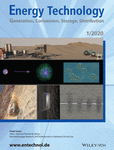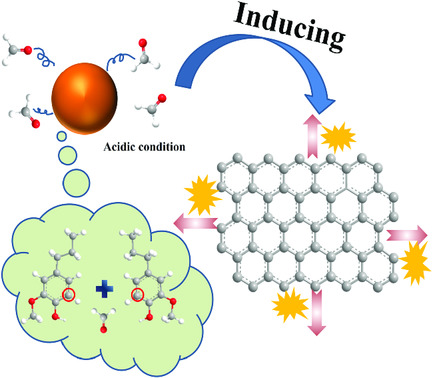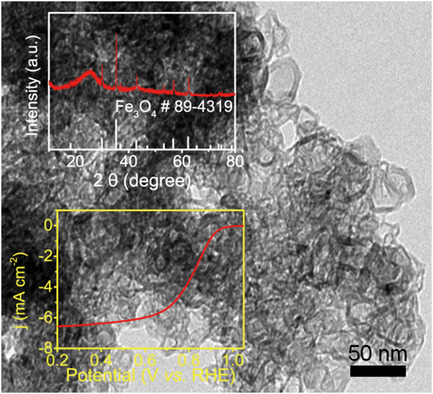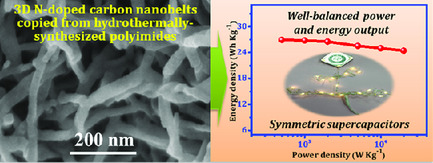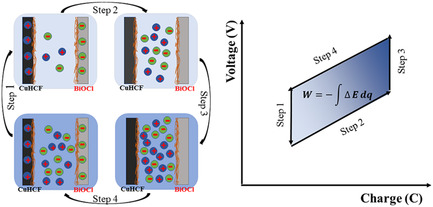Journal list menu
Export Citations
Download PDFs
Cover Picture
Nanotechnology Research and Development in Upstream Oil and Gas
- First Published: 06 January 2020
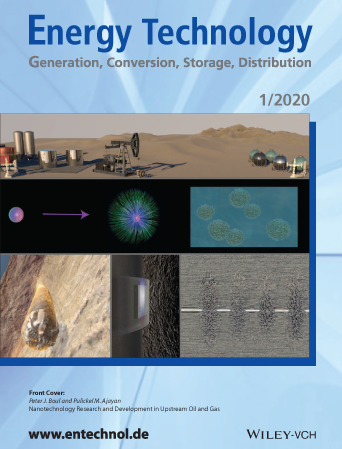
Many important processes and methodologies in upstream oil and gas show performance enhancements with nanomaterials. The implementation of advanced nanotechnologies in oil and gas is expected to result in higher efficiencies and lower costs leading to a reduction in the carbon footprint of hydrocarbon extraction and higher safety standards. More details can be found in article number 1901216 by Peter J. Boul and Pulickel M. Ajayan.
Masthead
Corrections
Reviews
Nanotechnology Research and Development in Upstream Oil and Gas
- First Published: 29 October 2019
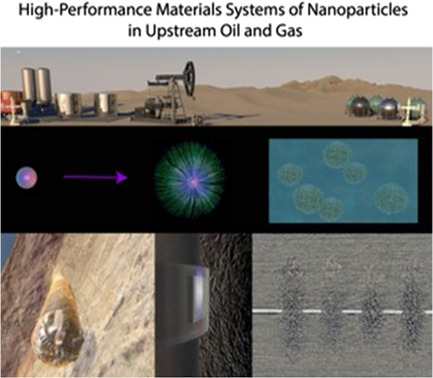
Research in nanomaterials has brought many performance enhancements in high-performance oil well construction, production enhancement, and reservoir management materials. Exciting developments are being witnessed in smart self-sensing cements, advanced production technologies, enhanced oil-recovery technologies, nanoparticle sensors, sensor networks, and downhole power and automation. Herein, a brief overview of the applications of nanoparticles and their potential as disruptive technologies is provided.
Full Papers
Energy Analysis of Physical Absorption and Chemical Absorption of CO2 in Ionic Liquids
- First Published: 04 September 2019
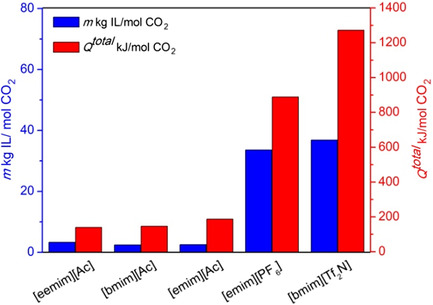
The physical absorption of CO2 in choline-based ionic liquids (ILs) and the chemical absorption of CO2 in acetate-based ILs is studied. The energy demands of CO2 in both pressure- and temperature-swing processes are calculated. The results show that the acetate-based ILs are effective both in terms of the amount of ILs consumed and the total energy demands.
Stabilizing the Structure of Nickel-Rich Lithiated Oxides via Cr Doping as Cathode with Boosted High-Voltage/Temperature Cycling Performance for Li-Ion Battery
- First Published: 08 September 2019
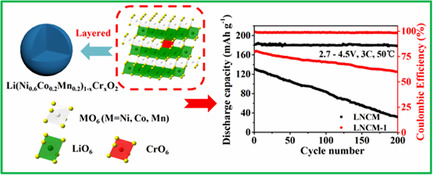
A moderate amount of Cr3+ in LiNi0.6Co0.2Mn0.2O2 can not only expand pathways for Li-ion insertion and extraction, but also suppress the Ni2+ content, thus reducing cation mixing and improving the order of the crystal structure. The electrochemical performance for the moderate amount of Cr3+-doped material is remarkably improved, especially under harsh conditions.
Optimizing the Crystallite Structure of Lignin-Based Nanospheres by Resinification for High-Performance Sodium-Ion Battery Anodes
- First Published: 11 September 2019
Molten Salts–Assisted Fabrication of Fe, S, and N Co-Doped Carbon as Efficient Oxygen Reduction Reaction Catalyst
- First Published: 11 September 2019
Boron and Nitrogen Co-Doped Trimodal-Porous Wood-Derived Carbon for Boosting Capacitive Performance
- First Published: 11 September 2019

Wood-derived carbon, integrating B, N co-doping, and a trimodal-porous structure, are obtained from a green modified hypersaline route. The resulting pore and heteroatom reengineered porous carbon harvests a remarkable specific capacitance of 479 F g−1 and high energy density of 18.5 Wh kg−1, as well as good rate capability in aqueous supercapacitors.
A Simple Glucose-Blowing Approach to Graphene-Like Foam/NiO Composites for Asymmetric Supercapacitors
- First Published: 14 September 2019

A one-step Ni(NO3)2-assisted glucose-blowing approach is developed to prepare graphene-like foam/NiO composites (GLF/NiO) with a relatively low temperature (650 °C). The GLF/NiO shows an interconnected vesicular structure, which can promote electronic conduction, ion penetration, and utilization efficiency of the active material, therefore achieving high electrochemical performance as a positive electrode of asymmetric supercapacitors.
High-Performance Fuel Cells Based on In2O3–La/Pr-Doped Ceria Semiconductor–Ionic Conductor Materials Electrolyte
- First Published: 18 September 2019
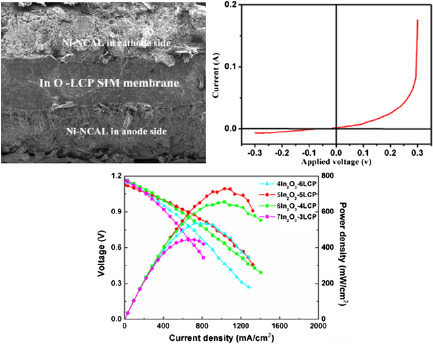
Herein, the first application of In2O3–La/Pr-doped ceria (LCP) semiconductor–ionic conductor materials (SIMs) as the electrolyte in a Schottky fuel cell is demonstrated. The superior ionic conductivity of SIMs and the built-in field of Schottky junction contribute to the superior performance of fuel cells, that is, Pmax of 730 mW cm−2 at 550 °C and 370 mW cm−2 even at 500 °C.
Highly Structured Nanofiber Zeolite Materials for Biogas Upgrading
- First Published: 30 September 2019
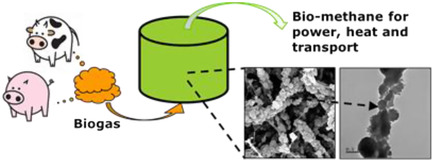
Highly structured zeolite/carbon (ZSM/C) nanofiber pellets are developed by an electrospinning technique for biogas upgrading. As compared with the nonstructured ZSM nanopowder, the ZSM/C nanofiber adsorbent offers a 30.4% increase in Brunauer–Emmett–Teller (BET) surface area, has the excellent tensile strength to withstand pressure swings, and shows a much higher mass transfer coefficient and CO2 uptake rate in the breakthrough tests.
Scalable Polymerization Approach to Tailoring Morphologies of Polyimide-Derived N-Doped Carbons for High-Performance Supercapacitors
- First Published: 30 September 2019
Defect-Rich Graphene Architecture Induced by Nitrogen and Phosphorus Dual Doping for High-Performance Supercapacitors
- First Published: 18 September 2019
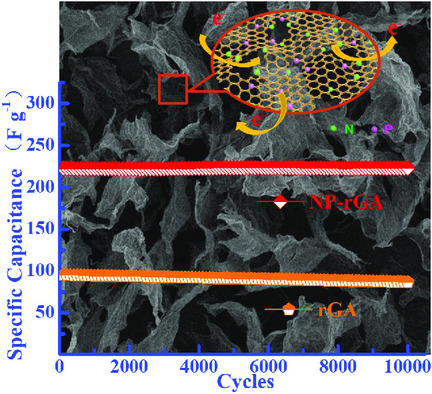
A nitrogen and phosphorus dual-doped reduced graphene architecture (NP-rGA) is constructed as a pseudocapacitive electrode material for supercapacitors. The excellent capacitive behaviors of NP-rGA are determined by the unique hierarchical structure for fast ion diffusion and the formation of rich defect sites induced by heteroatom doping, while the fast faradic reaction occurs.
In Situ Growth of BiOI/MoS2 Heterostructure as Pt Supports for Visible Light-Assisted Electrocatalytic Methanol Oxidation Reaction
- First Published: 30 September 2019
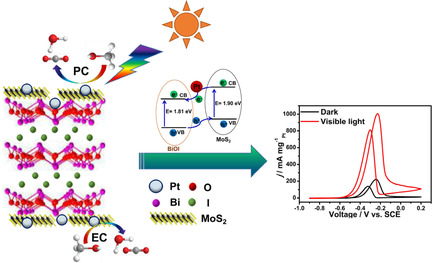
The synergistic effects of the electro- and photo-catalytic methanol oxidation reaction (MOR) of Pt-BiOI/MoS2 contribute to enhanced catalytic MOR performance. The photoelectrocatalytic performance of the Pt-BiOI/MoS2 electrode is 4.5 times higher than the same electrode in traditional electrochemical methods.
Trade-Off between Exciton Dissociation and Carrier Recombination and Dielectric Properties in Y6-Sensitized Nonfullerene Ternary Organic Solar Cells
- First Published: 25 September 2019
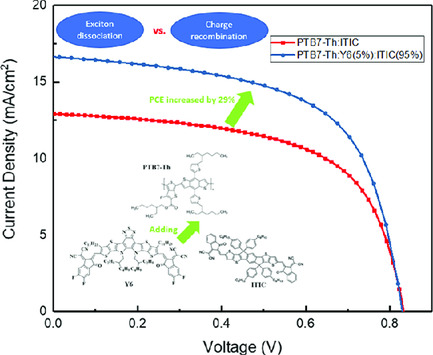
Herein, a novel ternary organic solar cell based on a PTB7-Th:Y6:ITIC blend with the power conversion efficiency (PCE) enhancement of 29% is reported. A trade-off is surprisingly found to exist between the exciton dissociation and carrier recombination process. The addition of the nonfullerene acceptor Y6 in the ternary blend is found as a more efficient exciton dissociation process, but accelerates the free carrier recombination process.
Facile Synthesis of Copper Sulfide Nanosheet@Graphene Oxide for the Anode of Potassium-Ion Batteries
- First Published: 24 September 2019

Copper sulfide (CuS) nanosheets uniformly anchored on graphene oxide, which are utilized as an anode material for potassium-ion batteries (PIBs), exhibit a preeminent specific capacity of 410 mAh g−1 and outstanding rate capability. The phase evolution of CuS during the potassium-ion insertion and extraction process is further explored by in situ X-ray diffraction studies.
Polyelectrolyte-Coated Copper Hexacyanoferrate and Bismuth Oxychloride Electrodes for Efficient Salinity Gradient Energy Recovery in Capacitive Mixing
- First Published: 18 September 2019
An Efficient and Extremely Stable Photocatalytic PtSe2/FTO Thin Film for Water Splitting
- First Published: 19 September 2019
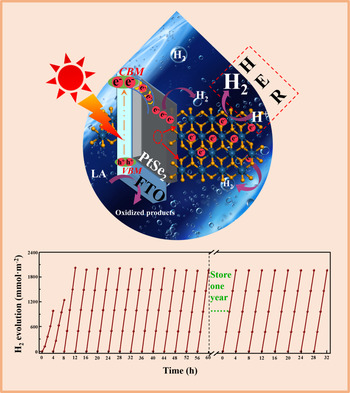
PtSe2 thin films are synthesized by thermal evaporation of Pt onto commercial fluorine-doped tin oxide (FTO) substrates and direct selenization through chemical vapor deposition. The PtSe2/FTO film exhibits outstanding hydrogen evolution reaction activity and ultrastability. The findings pave a new route for designing and constructing high-efficiency and highly stable photocatalytic film systems with applications in converting solar energy into chemical fuels.
Superhydrophilic Al-Doped NiP2 Nanosheets as Efficient Electrocatalysts for Hydrogen Evolution Reaction
- First Published: 25 September 2019
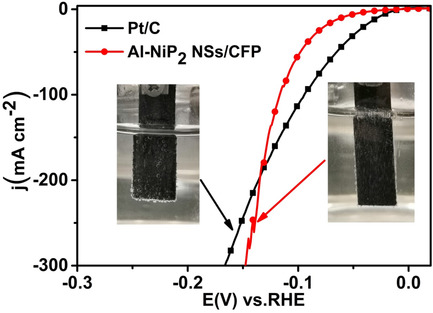
Self-supported Al-doped NiP2 nanosheet arrays with a superhydrophilic and aerophobic surface are synthesized by in situ solid-phase phosphidation via vacuum encapsulation technique. They exhibit excellent hydrogen evolution reaction (HER) activity at high current densities due to the rapid release of H2 bubbles on the electrode surface.
Reticulated Mesoporous TiO2 Scaffold, Fabricated by Spray Coating, for Large-Area Perovskite Solar Cells
- First Published: 26 September 2019
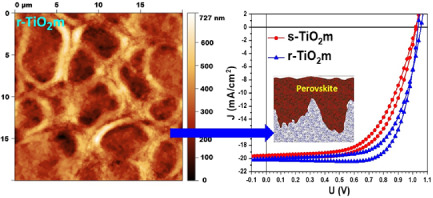
Herein, the fabrication of mesoporous TiO2 scaffolds using a large-area deposition technique, spray coating, is presented. The technique induces the formation of a specific reticulated structure with well-delimited cavities, resulting in an overall increase in roughness of one order of magnitude, compared with spin-coated mesoporous scaffolds. This mesoporous TiO2 scaffold improves the power conversion efficiency (PCE) of perovskite solar cells.
Toward Optimal Metal–Organic Frameworks for Adsorption Chillers: Insights from the Scale-Up of MIL-101(Cr) and NH2-MIL-125
- First Published: 05 September 2019

The metal–organic frameworks (MOFs) MIL-101(Cr) and NH2-MIL-125 are evaluated as adsorbents for adsorption chillers. Despite the high capacity of MOFs, efficiency and power density are up to 66% lower compared with Siogel. Material development goes beyond increasing capacity and tunes the shape of the isotherms to the specific operating temperatures. Then, MOFs outperform Siogel by factor 2.
Modification of Li4Ti5O12 Anodes Using Epoxy-Functionalized Silane to Improve Electrochemical Performance in Lithium-Ion Batteries
- First Published: 04 September 2019
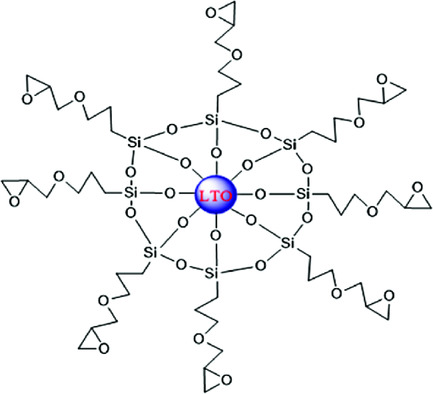
Li4Ti5O12 (LTO) modified with KH560 by a simple hydrolysis method can improve its dispersion performance, thereby improving the electrochemical performance of lithium-ion batteries. Under the condition of 2 C, KH560–LTO (0.5 wt%) exhibits higher discharge capacity (152.2 mAh g−1) after 100 cycles. In addition, it shows better rate capability (133.2 mAh g−1 at 10 C).
Salt-Resistant Carbon Nanotubes/Polyvinyl Alcohol Hybrid Gels with Tunable Water Transport for High-Efficiency and Long-Term Solar Steam Generation
- First Published: 09 October 2019
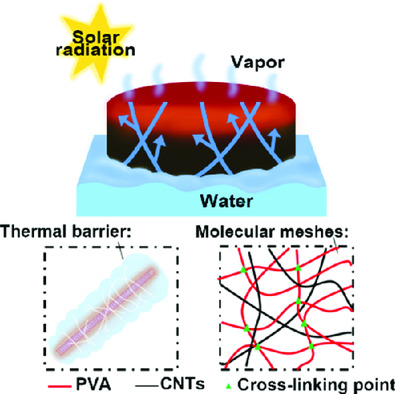
A polyvinyl alcohol (PVA)-wrapped carbon nanotube hybrid gel with a high evaporation rate and energy efficiency is designed by means of a freezing/thawing process with crosslinkers. Due to the bimodal porous structure containing internal capillary channels and molecular meshes in the gel, it also achieves excellent salt-resistant properties and long-term stability.
Continuous Hydrothermal Synthesis of Metal Germanates (M2GeO4; M = Co, Mn, Zn) for High-Capacity Negative Electrodes in Li-Ion Batteries
- First Published: 01 August 2019
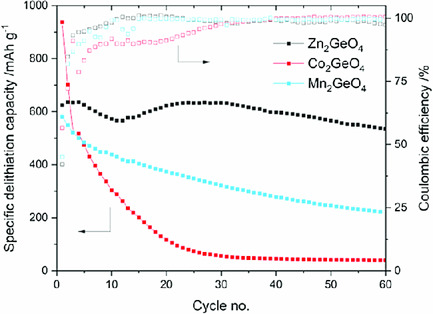
Continuous hydrothermal flow synthesis of nanosized metal germanates (M2GeO4; M = Co, Mn, Zn) is conducted for the first time. These materials show both alloying and conversion reactions associated with Ge and impressive specific capacities of 600 mAh g−1 (Zn2GeO4), 510 mAh g−1 (Mn2GeO4), and 240 mAh g−1 (Co2GeO4).
Transforming Ni-Coagulated Polyferriertic Sulfate Sludge into Porous Heteroatom-Doped Carbon-Supported Transition Metal Phosphide: An Efficient Catalyst for Oxygen Evolution Reaction
- First Published: 09 October 2019
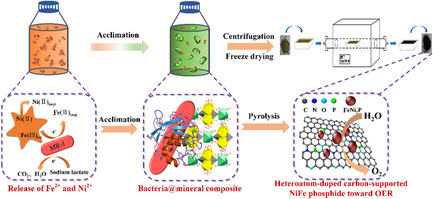
Ni-coagulated polyferriertic sulfate sludge can be reduced by Shewanella oneidensis MR-1 to form the MR-1@Fe/Ni-mineral composite, in which proteins with surface functional groups produced by MR-1 can positively interact with minerals via a chemical bond. This biogenic product is an attractive precursor to synthesize mesoporous heteroatom-doped carbon-supported NiFe phosphide (FeNi2P@HDC) that delivers outstanding oxygen evolution reaction (OER) performance.
Prepotassiated V2O5 as the Cathode Material for High-Voltage Potassium-Ion Batteries
- First Published: 01 October 2019

K0.486V2O5 nanobelts are synthesized by a novel hydrothermal method. The K0.486V2O5 nanobelts are used as the cathode of nonaqueous high-voltage potassium-ion batteries (PIBs). The stabilization of K+ ions remaining between VO layers at 4.2 V is revealed by in situ Raman and ex situ X-ray powder diffraction (XRD).
Coating of Rh/Mg/Al Hydrotalcite-Like Materials on FeCrAl Fibers by Electrodeposition and Application for Syngas Production
- First Published: 10 October 2019
Sequential Fractionation of Lignocellulosic Biomass Using CO2-Assisted Hydrolysis Combined with γ-Valerolactone Treatment
- First Published: 17 October 2019
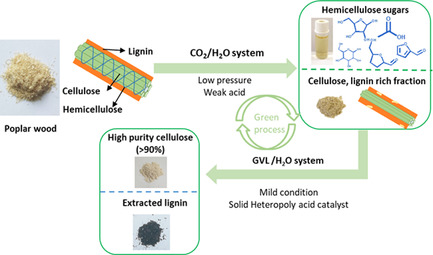
A green biomass biorefinery strategy for the selective fractionation of lignocellulose is reported. The selective hydrolysis of hemicellulose is performed in a CO2/H2O system. Subsequently, the extraction of lignin from the pretreated samples is conducted in a γ-valerolactone (GVL)/H2O system with solid heteropoly acids as the catalyst. This biorefinery strategy shows practical significance for the effective fractionation of lignocellulosic biomass.
Improved Reproducibility of PbS Colloidal Quantum Dots Solar Cells Using Atomic Layer–Deposited TiO2
- First Published: 17 October 2019
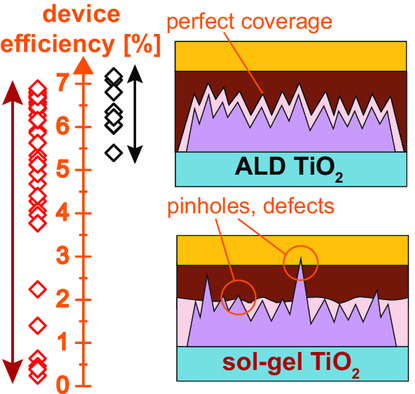
Atomic layer–deposited TiO2 electron transporting layer (ETL): morphological investigations demonstrate that imperfections in sol–gel (SG) TiO2 ETL cause the leakiness of PbS quantum dot (QD) solar cells. Atomic layer–deposited TiO2 is used as an ETL, resulting in a similar device performance to the previously optimized TiO2 made by SG approach, but showing a significant improvement in reproducibility.
Ammonium Fluoride Interface Modification for High-Performance and Long-Term Stable Perovskite Solar Cells
- First Published: 22 October 2019
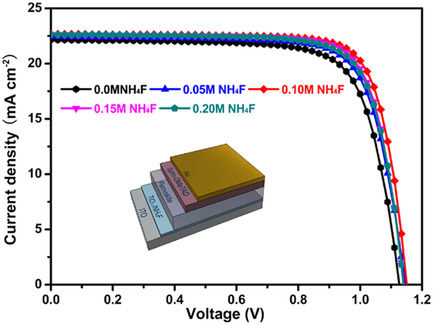
NH4F is used to modify the TiO2/perovskite interface, which mitigates and passivates the interface defects, decreases the carrier recombination, and increases the electron extraction and injection capacity. Consequently, the modified planar perovskite solar cell achieves a power conversion efficiency of 20.47%, whereas the pristine device achieves an efficiency of 18.59% under the same conditions.
Zn-Doped Porous CoNiP Nanosheet Arrays as Efficient and Stable Bifunctional Electrocatalysts for Overall Water Splitting
- First Published: 22 October 2019
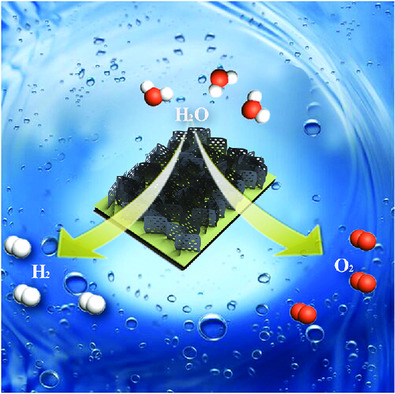
Porous Zn-doped CoNiP arrays on Ni foam (P-Zn-CoNiP/NF) are prepared by the first phosphatization of Zn–Ni–Co–O precursor anchored on NF, followed by treatment in dilute HCl solution. The material can be used as a bifunctional hydrogen evolution reaction/oxygen evolution reaction catalyst for effective water splitting with a current density of 50 mA cm−2 at a low cell voltage of 1.71 V.
Surfactant-Free Sol–Gel Synthesis Method for the Preparation of Mesoporous High Surface Area NiO–Al2O3 Nanopowder and Its Application in Catalytic CO2 Methanation
- First Published: 17 October 2019
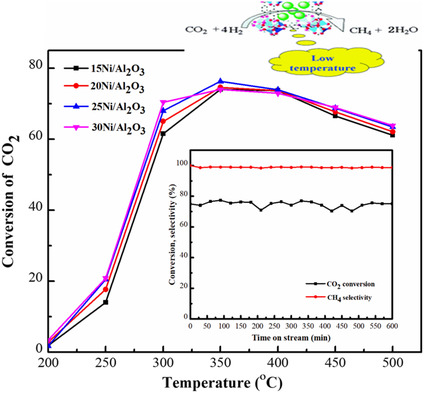
A group of nickel-based catalysts with different weight percentages of Ni are synthesized using a novel surfactant-free sol–gel method, and the prepared catalysts are used in the methanation of carbon dioxide. The Ni-Al2O3 catalyst of 30 wt% exhibits the highest catalytic performance and high stability in the methanation of carbon dioxide.




